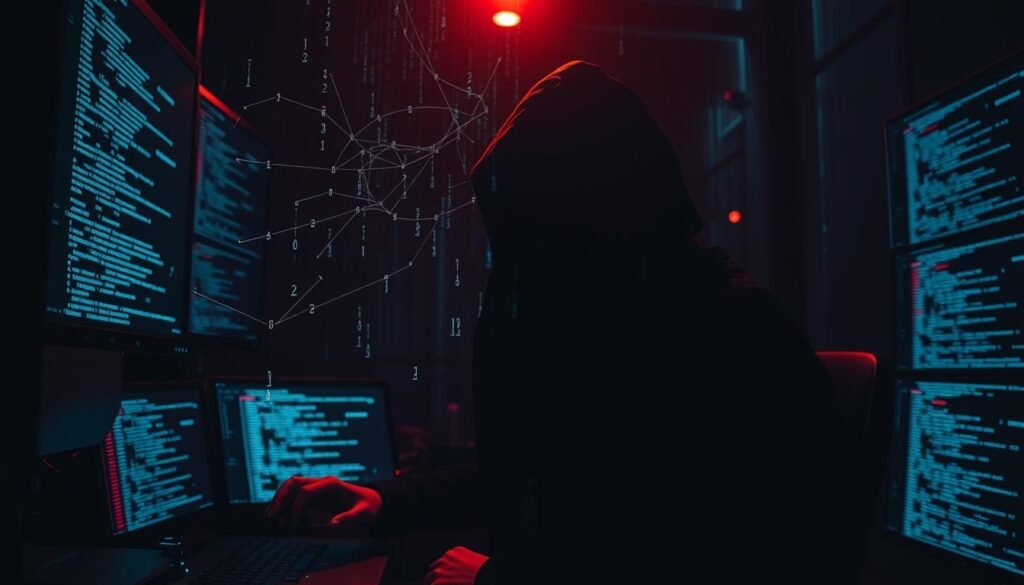Cybercrime costs the global economy a huge $6 trillion each year. In the world of black hat vs white hat hacking, the fight for digital safety never stops. Cybersecurity experts and hackers are always pushing the limits of tech battles.
The digital world is a complex battlefield. Different hackers play key roles here. Some try to find and use weaknesses, while others work hard to keep digital places safe. Knowing the difference can save or protect digital safety.
Cybersecurity is more important than ever. The SolarWinds attack is a recent example. It affected thousands of customers and led to the company being sold for $4.4 billion. This shows how big the impact of hacking can be.
Your online safety depends on knowing about hacking. There are hackers who harm and those who help keep things safe. This world is always changing.
Key Takeaways
- Cybercrime is a huge threat to the global economy
- Hackers can be grouped into different ethical categories
- Cybersecurity is a constant fight between protection and exploitation
- Knowing about hacking types is key to keeping things safe online
- Technology keeps changing the hacking world
Introduction
The digital world is a complex battlefield. Cybersecurity experts and hackers play a high-stakes game of cat and mouse. It’s important to understand the world of hacking in today’s connected world.
Hacking is not just one thing. It’s a world of digital interactions, from harmful to helpful. Cybersecurity experts see many ways to interact digitally, challenging old security ideas.
What Exactly is Hacking?
Hacking means getting into computer systems or networks without permission. The reasons for hacking vary a lot:
- Ethical hackers vs cybercriminals have different goals
- Hackers might want money or to make things safer
- What they believe in matters a lot
Understanding Hacker Types
| Hacker Type | Primary Motivation | Ethical Standing |
|---|---|---|
| White Hat | Improve Security | Fully Ethical |
| Black Hat | Financial Gain/Damage | Unethical |
| Gray Hat | Curiosity/Exposure | Ambiguous |
“In the world of cybersecurity, intent defines the difference between a protector and a threat.” – Cybersecurity Expert
About 67% of cyber-attacks use weaknesses found by ethical hackers. This shows how important it is to be proactive in keeping digital places safe.
What is Black Hat Hacking?

Black hat hacking is the most dangerous part of cybersecurity. These cybercriminals use computers to harm others, looking for weak spots in networks and personal info. Black hat hacking explained shows a world where hackers aim to make money through smart attacks.
The Dark Side of Cybersecurity
Cybercrime is a huge threat worldwide. By 2025, it’s expected to cost around $10.5 trillion a year. Black hat hackers use many ways to get past security:
- Ransomware attacks
- Phishing schemes
- Network infiltration
- Data theft
How Hackers Break Security
Black hat hackers’ methods are getting smarter. They often find weak spots in:
| Target System | Potential Vulnerability |
|---|---|
| Email Accounts | Malicious software propagation |
| Mobile Devices | Open-source system weaknesses |
| Public Wi-Fi Networks | Unsecured connection points |
“Cybercrime is not just a technical challenge, but a complex ecosystem of digital threats.”
The effects of these attacks are huge. For example, the Colonial Pipeline ransomware attack in 2021 cost £3.34 million and shut down a key pipeline. These events show we need strong cybersecurity to fight black hat hacking.
What is White Hat Hacking?

In the world of cybersecurity, white hat hackers are the heroes. They protect organizations from bad guys. These ethical hackers use their skills to make security systems stronger and stop cyber attacks.
The job of a white hat hacker is key in today’s digital world. They use their knowledge to find and fix weaknesses before hackers can use them.
The Ethical Approach to Cybersecurity
Ethical hackers have a strict code of conduct. They aim to:
- Do thorough penetration testing
- Find system weaknesses
- Offer strong security advice
- Keep digital assets safe
Strengthening Security Through Strategic Testing
Penetration testing and malicious hacking are worlds apart. White hat hackers work to protect systems, not harm them.
“Ethical hacking is about building digital fortresses, not tearing them down.”
The need for white hat hackers is growing. Here are some facts:
- 62% of companies see them as vital for security
- Using ethical hacking services can cut security breaches by 50%
- Cybersecurity job ads have jumped 73% from 2017 to 2022
White hat hackers keep evolving and stay one step ahead. They are essential in fighting off cyber threats in our digital world.
Grey Hat Hackers: A Middle Ground

The world of cybersecurity isn’t just black and white. Grey hat hackers are in a gray area between right and wrong. They challenge the old rules of digital security. These skilled hackers often walk a fine line that fascinates many in the field.
Understanding the Grey Hat Approach
Grey hat hackers find weaknesses in computer systems without asking. They’re different from white hat hackers who follow the law. Their methods can be unorthodox, and they might not always get permission.
Their goal is to make digital security better. But, their actions can also break hacking laws and regulations.
- Identify system vulnerabilities without authorization
- Notify organizations about possible security risks
- Sometimes ask for money for the found vulnerabilities
Legal Risks and Ethical Dilemmas
Grey hat hackers face a tough choice between right and wrong. Even with good intentions, they can face serious legal trouble. Governments and companies are getting stricter about unauthorized checks.
“In the digital world, good intentions don’t always keep you safe from legal trouble.” – Cybersecurity Expert
| Action | Potential Legal Consequence |
|---|---|
| Unauthorized Vulnerability Scanning | Potential Criminal Charges |
| Exposing Security Weakness | Potential Lawsuit |
| Demanding Compensation | Extortion Allegations |
Even if grey hat hackers think they’re helping, the law is tough. Companies suggest using the right channels. This way, you can improve security and protect yourself legally.
Real-Life Examples of Black Hat and White Hat Hacking

The world of cybersecurity is a constant battle. It pits malicious hackers against ethical defenders. Real-world hacking incidents give us key insights into digital security.
Notorious Cybercriminals in Action
Black hat hackers have caused some of the biggest cyber attacks. Cybersecurity professionals vs hackers face big challenges in stopping these threats.
- Ransomware attacks increased by 500% from 2018 to 2021
- Average data breach cost reached $4.35 million in 2022
- A business falls victim to ransomware every 11 seconds
Ethical Hackers Saving the Day
The most famous ethical hackers are key in protecting our digital world. They use their skills to find and fix vulnerabilities before they can be used by bad guys.
| Ethical Hacker Achievements | Impact |
|---|---|
| Kevin Mitnick | Switched from black hat to consulting, helping companies get safer |
| Jeff Moss | Started DEF CON, the biggest hacking conference |
| Tsutomu Shimomura | Helped catch Kevin Mitnick and pushed forward in cybersecurity research |
“In the world of cybersecurity, the line between offense and defense is razor-thin.” – Anonymous Cybersecurity Expert
The cybersecurity market is growing fast, expected to hit over $300 billion by 2026. This shows how vital it is to understand and fight cyber threats. Your online safety relies on the hard work of these cybersecurity experts.
Conclusion
Exploring hacking shows how important cybersecurity experts are in keeping our digital world safe. The fight between good and bad hackers is ongoing. The cybersecurity field is expected to grow to $345.4 billion by 2026.
Hacking laws and rules are getting more strict. This is because cyber threats are increasing. Cybersecurity jobs are in high demand, with a shortage of 3.5 million jobs by 2025.
This shortage is a great chance for those wanting to work in ethical hacking. White hat hackers are the heroes, working hard to stop security breaches. These breaches could cost companies millions.
It’s vital to understand cybersecurity ethics today. Ransomware attacks happen every 11 seconds. Also, 91% of data breaches are caused by human mistakes.
Now, you know the difference between bad hackers and the good ones who protect us. Your exploration into hacking shows it’s a field full of opportunities. Whether you’re looking into a cybersecurity career or just want to keep your online presence safe, staying informed is key.
The future of cybersecurity is about the people, not just the tech. It’s about the experts who keep our digital world safe.
FAQ
What’s the main difference between black hat and white hat hackers?
Are all hackers criminals?
What motivates black hat hackers?
How do white hat hackers help cybersecurity?
Is hacking always illegal?
What skills do white hat hackers need?
How can companies protect themselves from black hat hackers?
What are the possible consequences of black hat hacking?
Can anyone become a white hat hacker?
What’s the difference between grey hat and black/white hat hackers?
Source Links
- Cyberattacks & Data Breaches recent news | Dark Reading
- Hack Rare: Engaging the Next Generation of Rare Disease Innovators – National Organization for Rare Disorders
- Understanding the Types of Ethical Hacking for Cybersecurity
- The Basics of Hacking and Penetration Testing | Summary, Quotes, Audio
- Hacktivism, Ethical Hacking, and Grey Hats – IKARUS Security Software
- What is Hacking? Protect Yourself from Cyber Threats
- Top 10 Most Famous Hackers in the World
- Clark Barron on LinkedIn: What exactly is a "White Hat" influencer? And why does LinkedIn…
- Spam Policies for Google Web Search | Google Search Central | Documentation | Google for Developers
- Nintendo Switch
- Nachrichten – FSFE
- Is Coding Compulsory for Cybersecurity? A Beginner’s Guide to Understanding Its Importance
- Top 60 Cyber Security Interview Questions and Answers (2025) – GeeksforGeeks
- Ethical Hacking Tools and Techniques for Beginners
- Difference Between Hacker and Cracker: Ethics, Roles & Skills
